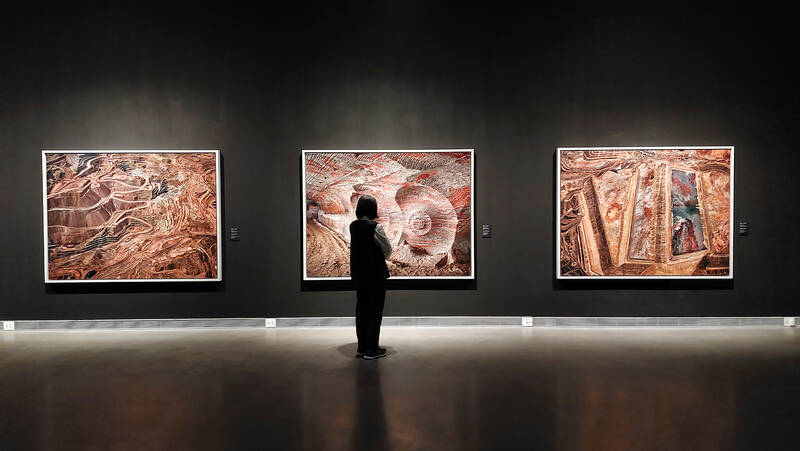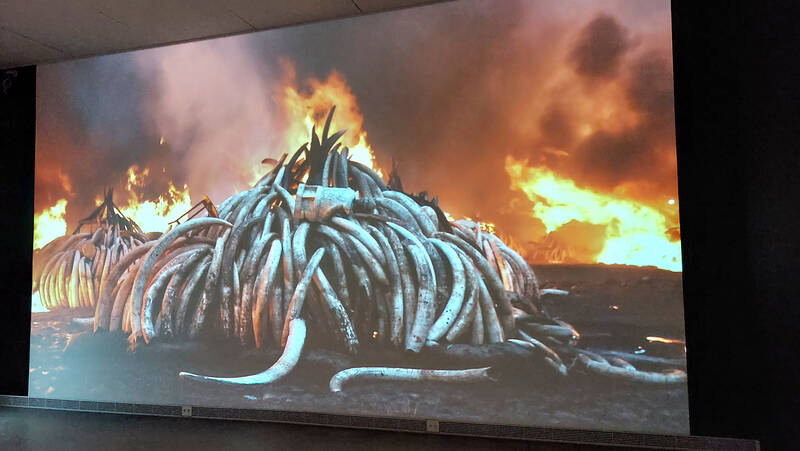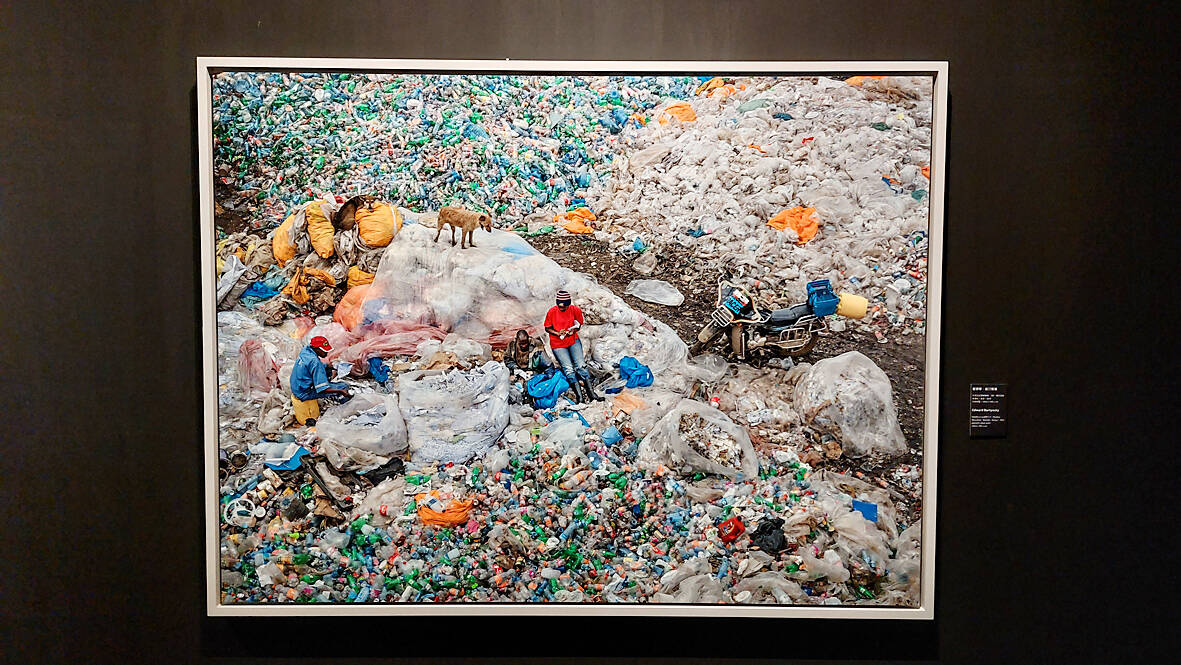Huge piles of elephant tusks and rhino horns confiscated from poachers go up in flames as smoke blacks out the sky. The scene, part of a video played on a giant screen in a dark room, is an installation from the “Anthropocene” exhibition at the Kaohsiung Museum of Fine Arts.
Most other pieces at the exhibition are similarly super-sized and awe-inspiring. The smallest photo prints are almost as tall as an average person — a likely attempt by photographer Edward Burtynsky and documentary directors Jennifer Baichwal and Nicholas de Pencier to underline the immensity of their subject matter: to document the geographical and ecological changes wrought upon our planet by human beings.
Burtynsky’s photographs anchor the exhibition occupying three halls. Visitors to the first hall are greeted by a 6-meter wide print of a marble quarry in Italy showing an excavator working in front of a sheer rock face shaved off in neat, straight lines. The image is flanked by a smaller picture of an outcrop from Spain displaying dozens of rocky strata layered on top of each other in a wavy pattern, underlining the contrast between the natural and the human-made.

Photo: Doruk Sargin
Imagery that has become the staples of environmentally-conscious exhibitions — people standing in landfills, garbage-strewn rivers and polluted waterways — are sparse in “Anthropocene,” as it seeks to depict the human state as is, without judgement. And so visitors are treated to aerial photographs of a highway cutting through a suburban neighborhood in California, a busy intersection in Lagos and phosphate production plants in Florida. Added to these are images of perfectly rectangular lithium mines from Chile, where booming demand for electric car batteries is transforming the Atacama Desert, which, normally, should be devoid of human life. In the second hall, however, the line between the natural and the human-made becomes blurred as what appears to be a close-up photograph of an ammonite is revealed to be an aerial image of a potash mine in Russia.
The artists have also made a distinction between “good Anthropocene “ and “bad Anthropocene.” An example of the former is displayed in a video called Danger Trees by Baichwal and De Pencier, showing trees that pose a danger to humans or the environment in Vancouver being exploded in controlled detonations to bring them down. The trees are then left on the forest floor to decompose naturally. The artists argue that this quickens the natural pace of the decomposition process, and causes no harm to the environment.
The exhibition also takes a different approach to the problem of coral bleaching. Instead of filming or photographing destroyed corals, Baichwal and De Pencier collected coral samples, placed them in an enclosure mimicking their natural habitat and subjected them to the stresses caused by climate change. The result is a striking time-lapse video showing vibrant corals fading away as symbiotic algae crucial to the corals is wiped out.

Photo: Doruk Sargin
The adjoining room houses the video installation showing the burning tusks and rhino horns. The scene is from 2016, when the Kenyan government set on fire hundreds of tusks and horns it confiscated over the decades, to send the world the message that the illegal trade had come to an end. However, the effort was too little, too late, as the last male northern white rhinoceros died in 2018, leaving behind only two females of its kind.
Despite its somber subject matter, “Anthropocene” is a refreshing break from similar works, free from pretense and finger-pointing. Rather than burdening the visitors with a sense of guilt, the exhibition imbues a sense of awe and wonder for the great changes humanity has brought about simply by existing. As Baichwal declares, its goal is “to not preach, harangue or blame, but to witness, and in that witnessing, try to shift consciousness.”

Photo: Doruk Sargin

On April 26, The Lancet published a letter from two doctors at Taichung-based China Medical University Hospital (CMUH) warning that “Taiwan’s Health Care System is on the Brink of Collapse.” The authors said that “Years of policy inaction and mismanagement of resources have led to the National Health Insurance system operating under unsustainable conditions.” The pushback was immediate. Errors in the paper were quickly identified and publicized, to discredit the authors (the hospital apologized). CNA reported that CMUH said the letter described Taiwan in 2021 as having 62 nurses per 10,000 people, when the correct number was 78 nurses per 10,000

As we live longer, our risk of cognitive impairment is increasing. How can we delay the onset of symptoms? Do we have to give up every indulgence or can small changes make a difference? We asked neurologists for tips on how to keep our brains healthy for life. TAKE CARE OF YOUR HEALTH “All of the sensible things that apply to bodily health apply to brain health,” says Suzanne O’Sullivan, a consultant in neurology at the National Hospital for Neurology and Neurosurgery in London, and the author of The Age of Diagnosis. “When you’re 20, you can get away with absolute

May 5 to May 11 What started out as friction between Taiwanese students at Taichung First High School and a Japanese head cook escalated dramatically over the first two weeks of May 1927. It began on April 30 when the cook’s wife knew that lotus starch used in that night’s dinner had rat feces in it, but failed to inform staff until the meal was already prepared. The students believed that her silence was intentional, and filed a complaint. The school’s Japanese administrators sided with the cook’s family, dismissing the students as troublemakers and clamping down on their freedoms — with

As Donald Trump’s executive order in March led to the shuttering of Voice of America (VOA) — the global broadcaster whose roots date back to the fight against Nazi propaganda — he quickly attracted support from figures not used to aligning themselves with any US administration. Trump had ordered the US Agency for Global Media, the federal agency that funds VOA and other groups promoting independent journalism overseas, to be “eliminated to the maximum extent consistent with applicable law.” The decision suddenly halted programming in 49 languages to more than 425 million people. In Moscow, Margarita Simonyan, the hardline editor-in-chief of the